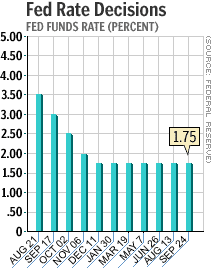NEW YORK (CNN/Money) - A divided Federal Reserve held interest rates steady Tuesday, saying the U.S. economy still is at risk of weakness and citing uncertainty about the economic impact of a war with Iraq.
As widely expected, Fed policy-makers decided to leave their target for the federal funds rate, an overnight bank lending rate, unchanged at 1.75 percent, the lowest level in more than 40 years. The Fed also left its symbolic discount rate unchanged at 1.25 percent.
In an unusual development, two of the 12 policy-makers -- Fed Governor Ed Gramlich and Dallas Fed President Robert McTeer -- dissented from the decision, saying they would have preferred a rate cut. It was the first dissent among the central bank's policy-makers since Thomas Hoenig, president of the Kansas City Fed, objected to a rate cut on Dec. 11, 2001.

"I really don't read a lot into [the dissent]; it doesn't mean that's the direction policy is going to head," said Gary Thayer, chief economist at A.G. Edwards. "Some people interpret the risks differently than others, and that's what's happened this time."
Other observers, however, noted that such unusual dissent -- it was the first time two policy makers had objected to a Fed decision since May 1998, when two members wanted the inactive Fed to raise interest rates -- indicated there was a strong possibility the Fed would lean toward cutting rates at its November meeting.
"They still feel there's enough activity in the economy that they don't need to cut yet," said Robert MacIntosh, chief economist at Eaton Vance Management. "Come November, if things are still as sluggish as they seem to be, they'll have to do something then."
In the closely watched statement accompanying its decision, the Fed again said that, while its monetary policy was already providing plenty of stimulus, the economy is in greater danger of additional weakness rather than inflation.
"The information that has become available since the last meeting of the Committee suggests that aggregate demand is growing at a moderate pace," the Fed said in its statement.
The Fed also referred to uncertainty due to "the emergence of heightened geopolitical risks," a nod to growing worries about the economic impact of a war with Iraq.
"Like the rest of us, business leaders cannot figure out what will happen if war breaks out, and making business plans in such an unclear environment is quite difficult," said Joel Naroff, president and chief economist of Naroff Economic Advisors.
The Fed's decision was widely expected on Wall Street, but stock prices fell after the decision anyway. Treasury bond prices rose.
Mounting evidence of weakness
The fed funds rate is the basis for many banks' prime lending rates and affects the cost of borrowing for consumers and businesses. The central bank cuts rates when it wants to stimulate the economy and raises them when it wants to slow the economy down and fight inflation.
It cut rates 11 times in 2001 to fight a recession that the National Bureau of Economic Research said began in March of that year. Low rates also have helped keep mortgage rates low, fueling the housing market and boosting homeowners' equity, which has helped keep consumers spending.
Earlier this year, most economists thought the Fed would be raising rates by at least a quarter percentage point in August.
That expectation was turned on its head by persistent stock market weakness in June and July, raising fears that the weakness could erode consumer and business confidence and slow the economy down again.
Since then, economic data have been mixed, showing declines in consumer confidence, some strength in consumer spending on automobiles and homes, mixed retail sales, faltering industrial production and growing new weekly claims for unemployment benefits, even as the unemployment rate has dropped.
If the weaker data begin to prevail between Tuesday and the Fed's next policy meeting, scheduled for Nov. 6, another rate cut could be on the way.
| Related stories
|

|
|
|
|
"If spending holds up and job gains continue, even if they are nothing great, rates will likely not be reduced," Naroff said. "If the labor market turns negative and households put away their wallets, the [Fed] will undoubtedly react."
The Fed's statement seemed designed to specifically avoid promising a rate cut -- it did not say that policy makers were "closely monitoring" the economy, verbiage that's been taken in the past to hint at a cut possibly being made between policy meetings.
But the implied yield on the federal funds futures contract, -- a closely watched gauge of what traders are betting about the Fed's monetary policy -- indicates traders think there's an 88-percent chance the Fed will cut rates by its Nov. 6 policy meeting.

|

